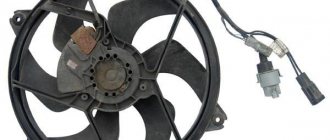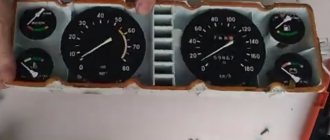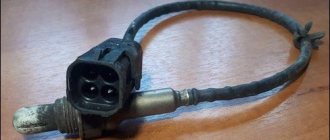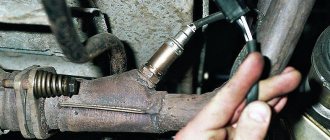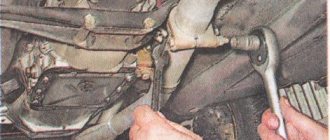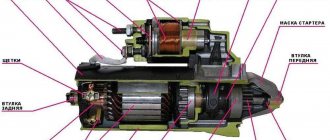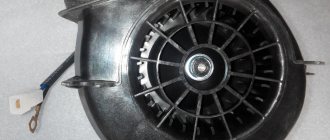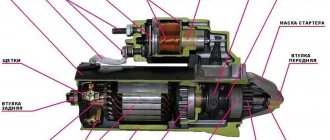Car owners will find out in the fall and winter that the injector or carburetor in the VAZ-2107 has stopped heating. Observant drivers are able to detect a malfunction of the stove in the summer - a breakdown of the heater is indicated by a leak of antifreeze or coolant. Without proper operation of the stove, it is impossible to increase the temperature inside the car; the air will blow cold.
A working stove raises the temperature well, so you shouldn’t endure and wait for the weather by the sea, especially if winter frosts are upon you - start repairing the heater yourself, and we’ll tell you how below.
The fan of the VAZ 2107 stove does not work.
Hello.
This time I will write about possible reasons for which the heater motor on the VAZ 2107 may not work. These reasons can also be attributed to other classic models such as the VAZ 2105, 2106, 2101, 2103, 2104. To check all variants of the malfunction you need Have at least a test lamp, or better yet, a multimeter.
If you find out that it is the heater motor that has broken down, then read the article “Replacing the heater motor in a VAZ 2107.”
To understand what can break and why the VAZ 2107 heater fan may not spin, you need to consider the electrical circuit for powering this motor.
Connection diagram for the VAZ 2107 heater fan.
The diagram below shows how the stove fan (4) . Power from the battery, through the mounting block (1) , goes to the ignition switch (5) and again goes to the mounting block (1) . In the mounting block (1) it passes through fuse F1 (10 amperes) and goes to the stove speed switch button (2) . Next, power from the button goes either through resistance (3) to the motor (4) , or directly to the stove motor (4) .
The VAZ stove fan will not work if any of its circuit components is faulty. You can determine the reason why the VAZ 2107 heater fan does not work:
- There is a fault in the mounting block.
- The contacts of the heater fan speed switch are burnt out.
- The speed control resistance has burned out.
- There is a malfunction in the heater motor itself.
Let's take a closer look at each of the faults.
There is a malfunction in the VAZ 2107 mounting block.
If the stove stops blowing air, then first of all look to see if fuse F1 in the mounting block is intact. Usually, if this fuse blows, then the heated rear window and reverse lights stop working along with the heater. This fuse must be rated 10 amps . No more and no less. If you install a fuse of less than the nominal value, it will constantly burn out, and if you install a fuse of a higher nominal value, it is possible to burn the mounting block. If you have a fuse of a higher rating (as in the photo below), then the likelihood increases that the mounting block has failed and the plus is not supplied to the speed shift button. How to find out, read the next paragraph.
The contacts of the heater fan speed switch are burnt out.
You checked the fuse and saw that it was intact. Let's dig further. Now we take and remove the gear shift button from the panel and disconnect the wires from it. Afterwards, we reliably one end of the indicator light to ground, and alternately insert the other end into the removed terminals of the wires disconnected from the button. must be on !
If the light does not light up, then power is not supplied to the speed switch and the mounting block is most likely faulty.
If the light comes on when testing one of the contacts, it means either the button or something else is faulty. How to find out? Very simple! To do this, we make a jumper from a regular wire, from the contact, during the test of which the indicator light came on, to one of the other two contacts. The stove motor will work if the button is faulty. If the motor does not work, then it is the motor that is faulty.
The stove only works at one speed VAZ 2107.
When the stove operates only at the highest speed, this means that the ballast resistance has burned out.
In this case, just change it. It is located under the dashboard approximately in the middle, closer to the driver's side.
There is a malfunction in the heater motor itself.
Before disassembling the panel and stirring up the interior, check whether the mass going from the heater motor to the body sits well. It often happens that this wire simply rots.
If you have a multimeter, you can ring it. To do this, take out the speed switch button and disconnect the contacts from it. Now, in the continuity mode, connect one probe of the multimeter to ground, and check the wires with the others one by one. If the motor and ballast resistance are working properly, the multimeter will beep when checking two of the three wires. If the ballast resistance is faulty, then the multimeter will beep when checking one of the three wires, and if the heater motor does not work or does not have contact with ground, then the multimeter will be silent.
If you want to learn how to replace the stove motor, read this article!
I hope you found this article useful. If you have any questions or comments, leave them in the comments.
Heating and ventilation system design
Next, let's look at what kind of device the VAZ-2104 stove has, then how it works, as well as how the interior ventilation works.
For clarity, a diagram of the VAZ-2104 stove is provided
So, under position 1 there is a resistor for changing the fan speed. The base of the stove consists of a fan housing 2 and a blower fan guide 3 . They are connected to the upper part of the body with brackets 4 . The upper part of the housing is the radiator casing 5 . An air supply hatch 6 .
8 is located inside the upper part 7 is used to ensure its tight fit . This radiator is connected to the cooling system via metal pipes 9 . A valve 10 for supplying liquid to the radiator is installed on the incoming pipe.
The stove fan consists of an impeller 11 and an electric motor 12 . The fan is attached to the housing using a bracket 13 , and to prevent its vibration, it is pressed with a cushion 14 .
VAZ 2107 radiator fan does not work
The cooling system is designed in such a way that the fan starts only after the engine has warmed up to the set temperature. A malfunctioning fan switch can lead to serious engine problems.
Do not confuse this sensor with the coolant temperature sensor (DTOZH), which displays the engine temperature on the instrument panel and is installed on the right side of the engine.
It is possible to notice its breakdown in time only perhaps only in the summer, and even then in the city or when driving slowly, since the oncoming air flow is quite enough for the normal operation of the cooling system. The cooling system fan on VAZ 2107 cars starts with a characteristic noise, so the moment it starts is clearly audible.
Where is the switching temperature located?
The fan switching sensor is located on injection models, on the aluminum outlet pipe of the cylinder head (article - 23.3828, used in VAZ-2107i-2112, 21213, 2123, ALFA ROMEO, DAEWOO, FIAT, LANCIA, OPEL), on carburetor models (TM 108 -02 92/87 C) it is installed on the engine cooling radiator.
For the “classic” fan, the operating temperature is 92 degrees and the shutdown temperature is 87 C 0, so installing a fan that is suitable in size, but with a different number, is not recommended.
On carburetor models the sensor is located on the radiator
Checking the electric fan and its circuits
In order to check the operation of the fan and power circuits on the injection “seven”, you need to disconnect the connector from the sensor, the ECU will give a command to turn on the fan. If this does not happen, then you need to check not the sensor itself, but the serviceability of fuse F7, the electric motor, the fan relay and the power circuits. Below is a diagram of how to turn on the VAZ 2107 injector cooling fan.
Circuit diagram for switching on the VAZ 2107 cooling fan (injector)
The principle of operation of such a device differs from TM 108 and is based on a change in resistance.
As the sensor heats up, it reduces the resistance; the ECU monitors this change and, when the specified parameter is reached (about 195 Ohms), turns on the fan relay.
Heating scheme
Air flow diagram of the VAZ-2104 heating system
Cold air is supplied inside the heating system through the air intake grille 28 , installed near the windshield from the outside of the car. Further heating of the VAZ-2104 can be carried out in three directions, which are selected by the control system:
1 – heated windshield, this direction is indicated in red. With this scheme, air enters through hatch 7 into air supply box 30 to remove dust and water droplets. Then it moves through the radiator 25 , where it takes heat from the coolant, as well as the fan housing 13 , from where it enters the windshield heating duct 3 .
2 – heated side windows at the front, this direction is indicated in blue. Here the air also enters through the hatch into the box, then into the radiator casing 23 , and then enters the left and right air ducts 1 and 2 .
3 – heating of feet, this direction has a green designation. Air enters the cabin, as in other directions, but after the radiator casing it enters the internal ventilation duct 8.
Everything about the cooling radiator fan on the VAZ 2107
The design of the VAZ 2107 car provides a cooling system, which is based on such an important element as a fan. The main purpose of the VAZ 2107 radiator fan is to provide cooling of the radiator with coolant due to airflow. The element in question plays an important role on which the efficiency of a car engine depends. If the device malfunctions, the operation of the car cannot continue, since the result of such a breakdown is overheating and jamming of the engine.
Mechanical forced radiator cooling
Owners of some of the first sevens know how the mechanical cooling fan system works. The impeller of the device is driven by the rotating crankshaft rotor. The elements are connected using a belt drive, and the operation of the radiator cooling fan begins immediately after the engine starts.
This method of fan operation is called mechanical, and its main advantage is reliability. When the engine starts, the impeller of the device begins to rotate, thereby providing airflow to the radiator. Such a system is simple and therefore practically does not require repairs. The main disadvantage of this mechanism is that the rotation speed of the impeller directly depends on the engine speed. At idle, the impeller rotates at a lower speed than when moving at high speed.
If in the summer, when starting a VAZ 2107 with such an engine, the rotation of the fan does not negatively affect the warming up of the engine, then in winter it is the opposite. When starting the engine in winter, it is necessary to quickly warm up the engine, and the constant rotation of the fan complicates this task, even despite the cooling system, which consists of two fluid circulation circles - small and large.
The disadvantage of prolonged warm-up of the engine is eliminated by using a thermostat, which controls the circulation of coolant in a large and small circle. When the operating temperature is reached, when the engine warms up, the thermostat opens the valve and the liquid circulates in a large circle, that is, through the cooling radiator.
In winter, when the car is moving at high speed, the fan cools the liquid too quickly, so you will notice that on such sevens the temperature gauge needle often does not reach the operating value. This is why many car owners place cardboard or cloth on the radiator grille to prevent the flow of cold air.
Electric Radiator Cooling Fan
In the design of the VAZ 2107, more modern carburetor and injection versions, an impeller with built-in electric motors is installed, to which wires are connected together with a belt drive. The electric fan motor for cooling the radiator is activated by the activation of a sensor that measures the coolant temperature. As soon as the temperature in the system reaches the appropriate mark (over 90 degrees), the contact in the sensor closes and therefore the fan turns on.
Such a system cannot be called reliable, but in terms of efficiency, it is ahead of the mechanical system. Such a system cannot be called reliable, since during operation the electric motor, sensor may fail, the wiring may be damaged, or the fuse may blow. In terms of efficiency, such a system is a leader, since the fan is switched on only when the coolant temperature in the system reaches above the corresponding value. In this case, the fan does not work in vain, as is typical for “mechanical” sevens.
Checking the electric fan and its circuits
If the cooling fan does not work on a VAZ 2107 car of an injection or carburetor type, then you need to start troubleshooting from the sensor itself. The fan motor switch is very easy to check. To do this, you need to disconnect the terminal blocks from it (there are two of them) and short them to each other (with the ignition on). If after closing the contact the cooling device operates, then the fault is in the sensor itself. If the impeller does not rotate after this procedure, then the problem must be looked for elsewhere.
System management
In the VAZ-2104, the interior heating is controlled by the control panel handles, each of which ensures the closing and opening of one or another element.
Thus, the upper handle 9 ensures the opening and closing of the radiator valve 22 . It regulates the amount of liquid that will enter the radiator.
The middle handle 10 opens and closes the air supply hatch 7, which regulates the amount of fresh air supplied from outside the car.
The lower handle 11 regulates the position of the damper 16, which distributes the air flow through the air ducts.
There is one feature of air flow distribution control. When the flap 16 to blow the windshield, the heated flaps of the side windows are completely blocked. Conversely, when the air flow is blocked by the flap on the windshield, the air is directed only to the side windows.
This phenomenon is due to the fact that the windshield damper lever is connected to the side air duct damper lever. Therefore, to simultaneously heat the windshield and side windows, the damper control handle must be placed in the middle position.
Heating of the VAZ-2104 is carried out in 4 ways:
- Heated windshield (Middle and lower control panel handles are moved to the right all the way);
- Heated side windows (the middle handle is moved to the right, and the bottom handle is moved to the left all the way);
- Heating of feet (upper handle – to the right all the way, air distribution cover of the heater housing is lowered down);
- Supply of hot air from outside through lowered windows (sounds like a joke, but this is indicated in the technical documentation for the car);
VAZ 2107 fan does not work
Over the years of their production, VAZ-2107 cars were equipped with both carburetor and, subsequently, injection engines. Therefore, the electrical circuits for supplying voltage to the electric motor of the engine cooling system fan differ from each other.
On VAZ-2107 injection engines, a two-contact fan sensor, which is located in the upper pipe, when the coolant temperature rises above that for which it is designed, it must send a signal to the ECU. The electronic control unit, having analyzed the signal, turns on the fan through a relay.
Therefore, the search for reasons for the fan not turning on begins by removing the connector from the sensor with the ignition on. If the fan itself is working properly, then it should work. By inserting a load in the form of a light bulb into the connector terminals, the fan should stop. Thus, you check the electrical circuit of the fan motor. In this case, it will be fine, but the fan sensor will have to be replaced. However, it should be noted that there are also substandard sensors on sale, which, when installed on the engine, will also not work.
If, after removing the connector from the sensor, the fan does not work, then its functionality must be checked by connecting it directly to the battery. There are only two options for the experiment. If the fan is working, then you will have to check the functionality of the fuse that protects this circuit, the fan relay and the ECU. And if the fan does not work, then you will have to check the condition of its brushes for wear.
On carburetor engines of the VAZ-2107 car, there will be no ECU in the electrical circuit for turning on the fan, and some “sevens” do not even have a fan turn-on relay. Therefore, it is much easier to find the reason why the fan does not turn on, and many drivers of VAZ-2107 cars can cope with this.
2 comments
Thank you, you helped. Accessible and understandable.
Eng. I remove the chip from the sensor - it doesn’t turn. The fan is working (connected directly), I replaced the mother folders, the fuse is intact (the signal works), I changed the P3 relay under the glove compartment - no changes. The relay clicks when the ignition is turned on. The only thing I didn’t look at was the power supply unit for the burnt track. Tell me what the problem is.
Add a comment Cancel reply
- VAZ 2107
- 2109
- 2110
- 2112
- 2114
- 2115
- Vesta
- Kalina
- Lada Priora
- Lada Granta
- Lada Largus
- Chevrolet Niva
- Gazelle
- Logan
- Accent
- Octavia II
- Jetta V
- Patriot
- Nexia
- Aveo
- Focus 2
- Rio 2
- 80
- Qashqai
- Tiggo
- Astra
- Lancer
Popular posts:
- The radio does not work on the Lada Vesta
- The instrument panel does not work on the UAZ Patriot
- Why does the instrument lighting not work on the Priora?
- Why do the devices on the Gazelle not work?
- The washer does not work on Lada Largus
Search
The last notes:
Audi will take charge of Volkswagen Group's research and development efforts- Restyling Hyundai i30 2021 model year
- Volvo is redefining the concept of autonomous driving
Details about the new Kia Sorento 2021 before its debut presentation in Geneva
About Us:
Each of us faces problems while operating a car. It's always unpleasant. However, sometimes these problems can be solved on your own. The main goal of this site is to help motorists avoid unnecessary costs when repairing cars by suggesting the causes of the malfunction and options for eliminating it. We are focused on live communication, so we look forward to your comments and mutual assistance to other motorists. Thank you for being with us and good luck on the roads!
Contacts:
All rights to materials published on this site belong to the editors of the site, with the exception of cases of reprinting of other people's materials, and are protected in accordance with the legislation of the Russian Federation. If you found your photo or text on our resource, tell us about it. We will indicate your authorship or remove the material.
Exhaust ventilation
This car is also equipped with exhaust ventilation to remove air from the passenger compartment. Unfortunately, there is no diagram of this ventilation specifically for the VAZ-2104, but it is identical to the VAZ-2105 model, which is presented below:
So, 1 is the car heating system, 2 3 is hidden under it , through which air can escape when the windows are closed. The same valve prevents dust and moisture from entering the interior.
The most common problems
Thanks to its simple design, the heater of the 2107 VAZ model rarely breaks down. However, sometimes failures do happen. Most often this happens due to:
- sour faucet;
- clogged or cracked radiator;
- breakage of the cable drive.
It is the first of the mentioned elements that causes the greatest problems. The trouble is that in the winter the VAZ stove is actively used, while in the summer, of course, it sits idle for 4-5 months. Because of this, the tap often becomes clogged with solid particles contained in the antifreeze and jams. With the arrival of cold weather, it can be very difficult to open it, which is why the cable breaks or the locking fitting itself breaks. The faulty unit must be replaced.
The period of inactivity is also negatively displayed on the radiator. Without coolant circulation, deposits form on the coolant walls and oxidative processes are activated. As a result, the heat exchanger tubes become clogged, and subsequently the efficiency of the furnace as a whole decreases.
For preventive purposes, the radiator must be regularly washed with special compounds. Blockages are removed mechanically.
Leaks are another problem that often occurs with heaters. They occur due to the destruction of the faucet or loss of tightness of the joints of the pipes and radiator. The first two breakdowns are eliminated by replacing the failed element, and the last – by soldering. Fortunately, the original radiators on VAZ classics are made of copper, and therefore can be easily repaired.
Sometimes the fan also breaks. Problems here arise due to:
- motor burnout;
- wire break in the circuit;
- button failure.
Device
Periodic malfunctions in the operation of the heating system for the VAZ 2110 are an ordinary and common thing. Therefore, the owners of this model from the Russian automaker have to dig around in their own garage every now and then or send the car for repairs to specialists from service stations.
Heater circuit diagram
To understand exactly how to carry out repair and preventative measures, you first need to familiarize yourself with the diagram of the stove and its components.
Element
Peculiarities
A fan is mounted on it. Both elements contribute to the injection of heated air into the cabin
The entire operation of the heating system is based on this component. Remove the radiator and the heater will not work. Interestingly, the new model stove does not have a valve that shut off the flow of coolant through the radiator. Older devices have a faucet. The faucet was removed in order to avoid leaks, which were common on old stoves. Plus, they got rid of the tap for faster and more efficient heating of the interior. Although many owners of new tens do not agree with this decision, therefore, during repairs, they install a faucet on the stove
In total, the stove has three of them. The first is responsible for air intake recirculation, the second is for opening and closing the heater duct, and the third is intended for control and is considered the most important
This element is responsible for the speed of blowing hot air into the cabin.
All elements, including additional valves, shields, fittings, are combined into a single unit. It, enclosed in a housing, is located in the engine compartment near the dashboard.
Air ducts
Air ducts are another block of the heating system. They come from the stove and perform several different functions at once:
- The interior is ventilated through central nozzles;
- Distribute the air through an appropriate distributor that supplies heat or air for ventilation;
- Another pair of air ducts serve to heat the rear row of seats;
- The system, which includes five nozzles at once, warms the feet;
- A pair of side air ducts take over the functions of heating the glass and partially heat the interior. This makes heating more efficient;
- A pair of nozzles are used for ventilation.
Electronic stove control
This electronic control unit operates directly from the passenger compartment. It consists of two main elements.
- Pen. Using the controller knob, the user sets the required temperature, which the stove then generates. Control is carried out by turning the knob in one direction or another, depending on what degree of heating you require at the moment.
- Temperature sensor. It is responsible for activating the stove when the temperature drops by more than 2 degrees compared to the value set on the controller. The sensor is equipped with a micro motor. When the handle is in position A, the micromotor in the stove block turns on, the damper is activated, thereby causing proper heating.

